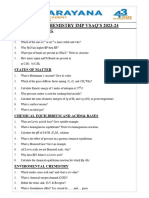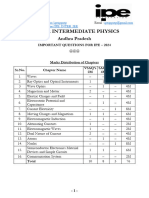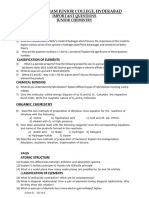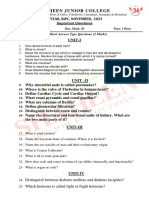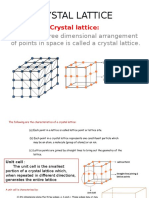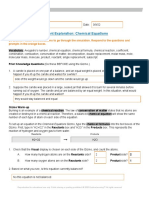Revision Questions
Uploaded by
Shazia FarheenRevision Questions
Uploaded by
Shazia FarheenSOME BASIC CONCEPTS OF CHEMISTRY REVISON X1 E AND B 1.
Define a) Law of Conservation of Mass b) Law of Multiple Proportions c) Gay Lussacs Law of Gaseous Volumes d) Avogadro Law e) One atomic mass unit f) mole g) Molar mass and molar volume h) Empirical Formula and molecular formula i) Law of Definite Proportions j) Mole Fraction k) Molarity l) Molality
2. What do you mean Limiting Reagent and excess reagent? 3. How does molarity changes with temperature? 4. Why molality is the best method to express concentration?
5. What is total mole fraction of all the components?
6. A compound contains 4.07 % hydrogen, 24.27 % carbon and 71.65 % chlorine. Its molar mass is 98.96 g. What are its empirical and molecular formulas ? 7. Calculate the amount of water (g) produced by the combustion of 16 g of methane.How many moles of methane are required to produce 22 g CO2 (g) after combustion? 8. 50.0 kg of N2 (g) and 10.0 kg of H2 (g) are mixed to produce NH3 (g). Calculate the NH3 (g) formed. Identify the limiting reagent in the production of NH3 in this 9. A solution is prepared by adding 2 g of a substance A to 18 g of water. Calculate the mass per cent of the solute. 10. Calculate the molarity of NaOH in the solution prepared by dissolving its 4 g in enough water to form 250 mL of the solution. 11. Calculate the mass of sodium acetate (CH3COONa) required to make 500 mL of 0.375 molar aqueous solution. Molar mass of sodium acetate is 82.0245 g mol 1.
12. Calculate the concentration of nitric acid in moles per litre in a sample which
has a density, 1.41 g mL1 and the mass per cent of nitric acid in it being 69%. 13. Dinitrogen and dihydrogen react with each other to produce ammonia according to the following chemical equation: N2 (g) + H2 (g)2NH3 (g) (i) Calculate the mass of ammonia produced if 2.00103 g dinitrogen reacts with 1.00103 g of dihydrogen. (ii) Will any of the two reactants remain un reacted? (iii) If yes, which one and what would be its mass?
ATOMIC STRUCURE
1. Write the configurations of chromium(24) and copper(29) give reason 2. Give Reasons for exceptional configuration of copper(Cu) and Chromium(Cr) 3. What is black body radiation? Explain Plancks quantum theory? 4. What is photoelectric effect? What is work function? 5. Write the expression for the following calculating Kinetic energy of ejected electron during photoelectric effect? 6. Complete the following a) Electrons are ejected from the metal surface ---------- light falls on it. b) The no of electrons ejected is proportional to the --------------------c) The kinetic energy of ejected electron increases by ------------------ on metal surface 7. Define the following terms a) Emission spectra b) Absorption spectra c) Define Quanta or photon 8. Explain hydrogen spectra?
Why atomic spectra is called as finger print of atom 10. What are the Application of Spectroscopy
11. Write the difference between orbit and orbital?
.9
12. Describe Bohrs model of atom? Mention its limitations. 13. What are stark and zeeman effect? 14. What is radial node and spherical node? How many nodded possible for 2 p orbital 15. State the foolowing a) Aufbau principle b) Pauli exclusive principle c) Hunds rule d) n+l rule 16. State the following a. de Broglie dual nature of electron b. Heisenberg uncertainty principle.
17. Show that circumference of the Bhors orbit for hydrogen atom is an
integral multiple of de Broglie wave length . QUANTUM NUMBERS and electronic configuration : 1) Write the electronic configuration of Cu-29 and Cr-24. 2) Write the quantum numbers of the valence electron in Na(z=11) in the ground state.
3) Which of the following orbital has highest energy.(a). n=3 , l=2 ml=+1 (b). n=4
l=0 , ml=0
4) How many unpaired electrons are there in Ni+2?
5. Which atom are indicated by the follwing electronic configuration .
a) [He]2S1 b) [Ne] 3S2 3P3
14. An electron is one of the 3d orbital, Give possible values of n and l. 15. How many electrons in an atom may have the following quantum numbers?
1. n=4 ms=-1/2 2. n=3 , ml=0
16. Arrange the following orbital in the order in which they may get filled. 3d,4S,4P,5S,4f.
17. What are the atomic numbers of the elements whose outer most electrons
are represented by (1). 3S1 (2). 2P3 (3).3P5 18. Using S,P,d,f Notation ,describe the orbital with the following quantum numbers. i. n=2, l=1 ii. n=4, l= 0 iii. n=5, l=3 19. The principle quantum number is n=3. a) Find no of orbital associated with it b) Find no of electrons present in it. 20. 21. Arrange the pair of orbital which experiences the larger effective nuclear charge. (a).2s, 3s (b).4d, 4f The unpaired electron is Al and Si is present in 3p orbital. Which electron will experience more effective nuclear charge? Very important numerical in atomic structure 22. The wavelength range of the visible spectrum extends from violet (400 nm) to red (750 nm). Express these wavelengths in frequencies (Hz). (1nm = 109 m)
Calculate energy of one mole of photons of radiation whose frequency is 5 1014 Hz.
23.
24. What are the frequency and wavelength of a photon emitted during a
transition from n = 5 state to the n = 2 state in the hydrogen atom?
25. Calculate the energy associated with the first orbit of He+. What is the
radius of this orbit?
26. What will be the wavelength of a ball of mass 0.1 kg moving with a velocity
of 10 m s1 ?
27. A microscope using suitable photons is employed to locate an electron in
an involved in the atom within a distance of 0.1 . What is the uncertainty measurement of its velocity?
28. A golf ball has a mass of 40g, and a speed of 45 m/s. If the speed can be measured within accuracy of 2%, calculate the uncertainty in the position.
29. Find energy of each of the photons which (i) Correspond to light of frequency 31015 Hz. (ii) Have wavelength of 0.50 . 30. What is the number of photons of light with a wavelength of 4000 pm that provide 1J of energy?
31. What is the wavelength of light emitted when the electron in a hydrogen
atom undergoes transition from an energy level with n = 4 to an energy level with n = 2?
Classification of elements and periodicity in properties.
1. State the
i) Mendeleev periodic law ii) Mosley modern periodic law 2) Write the IUPAC Name and symbol for the elements with atomic number 120. 110 and 116 3) Why do elements in the same group have similar chemical and physical properties?
4) Write the general electronic configuration and general properties of
following block of elements. i) s-block elements ii) p-block elements iii) d-block elements iv) f-block element 5) How do atomic radius varies in period and in group? Explain
6) What are iso-electronic species? 7) Explain why cation is smaller and anions larger in radii than parent
atoms. 8) Define following terms a) Ionization enthalpy b) Electron gain enthalpy c) electro negativity
9) account for the following
a) Second electron gain enthalpy of oxygen is positive. b) Cl has more electron gain enthalpy than F.
c) First ionization enthalpy of two isotopes of the same element to be the same. d) Be has higher I.E than Boron. e) N has Higher I.E than O . f) Nobel gas has the highest I.E. g) Group -17 elements ( halogens) have very high negative gain enthalpy. Application type questions
1. An electron belongs to 3rd period of p-block elemts.it has 4 e in
its outer most shell. predict its group. How many unpaired electrons its has?
2. An element has valence shell configuration ns2 np4.Predict the
group and period of the element . 3. Select the element with largest radius. Sate the reason .
(1) O,O-,O-2
4. Which of the following have most negative electron gain enthalpy and least. P, S ,Cl, F.
5. What are iso-electronic species ? arrange the following in the
increasing order of atomic size. Give reason K, K+ 2) Br ,Br- 3) O-2 ,FF-,O-2,Na+Mg
+2
6. In which of the following pairs which species has a larger size.
CHEMICAL BONDING AND MOLECULAR STRUCTURE 1. Define octet rule. Write its limitations. 2. What is lattice energy? What is the significance of it?
3. State Fazan's rule?
4. Define following bond parameters. a) Bond length. b) Bond energy 5. How do you express the bond strength in terms of bond order? 6. What is the bond order ? what is the bond order of N2 ? Lewis dot structure 1. Draw the Lewis structures for the following molecules and ions : H2S, SiCl4, BeF2, CO2, SO3,SO2, O3 ,NO2- ,HNO3 Resonance 1. What is the resonance? 2. draw the resonance in the following molecules.
SO3 ,SO2 NO2- , NO3-2,, HCOOVSERP THEORY:
CO2,
O3 , CO3-2
1. Predict the geometry of following molecules using VSEPR theory. SF4, H3O+, NH4+, CO3-2,H20,CO2, BeF2,BeCl2,NH2-,ClF3, NH3, SO2
2. BeF2 and H2o both are tri-atomic , yet they have different geometries.
Explain?
3. Geometries of NH3 and H20 are distorted tetrahedral. but bond angle in H20
is lesser than that of NH3. Explain . 4. Arrange the following molecules increasing order of bond angle? NH4+, CO3-2,H20,CO2, DI-POLE MOMENT : 1. What is Dipole Moment?
2
,NH2-, NH3, SO2
2. Although both CO2 and H2O are tri atomic molecules, the shape of H2O
molecule is bent while that of CO2 is linear. Explain this on the basis of dipole moment.
3. Explain why BeH2 molecule has a zero dipole moment although the BeH
bonds are polar.
4. Which out of NH3 and NF3 has higher dipole moment and why? 5. Dipole moment of BF3 is zero Explain? 6. Dipole moment of BeCl2is zero Explain?
Valence bond theory. 1. What do you understand by bond pairs and lone pairs of electrons? Illustrate by giving one example of each type. 2. Distinguish between a sigma and a pi bond.
3. Explain the formation of H2 molecule on the basis of valence bond theory.
HYBRIDISATION
1. What is meant by hybridization of atomic orbital? Describe the shapes of
sp, sp2, between carbon atoms in C2H4 and C2H2 molecules. 3. Predict the hybridization in the following molecules. Explain and Draw the shape of the molecules? NH3, NH+4,H2O, PCl5, SF6,BeCl2,BCl3, 4. What is the total number of sigma and pi bonds in the following molecules ? sp3 hybrid orbital. 2. Draw diagrams showing the formation of a double bond and a triple bond
(a) C2H2 ( b) C2H4
(c).C2H6
5. Explain hybridization in following molecules.
(a) C2H2 ( b) C2H4
(c).C2H6 (d).CH4
6. PCl5 is more reactive, explain in terms of shape of the molecule ? 7. Why in PCl5 axial bonds are longer than than equatorial bond ?
Molecular orbital theory 1. What is Bonding and anti bonding orbital? 2. Calculate Bond Order of following molecules.
H2 , H2 + , H2 O2, O2 +,O2-1, O2-2 B2 , Li2 ,N2,N2+
3. O2, O2 +,O2-1, O2-2 predict the stability order and magnetic behavior. 4. Use molecular orbital theory to explain why Be2 molecule does not exist? 5. What are iso-electronic species? Arrange the following in the
increasing order of atomic size. Give reason F-,O-2,Na+Mg
+2
You might also like
- Molar Mass by Freezing Point Depression PostlabNo ratings yetMolar Mass by Freezing Point Depression Postlab9 pages
- Board of Intermediate Education: Junior Inter Model Paper ChemistryNo ratings yetBoard of Intermediate Education: Junior Inter Model Paper Chemistry2 pages
- 1st Year Important Questions 2019 - 2020No ratings yet1st Year Important Questions 2019 - 20203 pages
- Previous Eamcet Physics - QP 30. Communication SystemNo ratings yetPrevious Eamcet Physics - QP 30. Communication System6 pages
- TS - JR - Physics Imp - Questions 2023-24No ratings yetTS - JR - Physics Imp - Questions 2023-244 pages
- TS - JR - Maths-1a - Imp Questions - 05-02-24100% (1)TS - JR - Maths-1a - Imp Questions - 05-02-247 pages
- SR Physics - Ipe - Important Questions: Very Short Answer Questions100% (1)SR Physics - Ipe - Important Questions: Very Short Answer Questions8 pages
- JR Chemistry Ipe Important Questions 02.01.2024No ratings yetJR Chemistry Ipe Important Questions 02.01.20247 pages
- AP EAMCET 2016 Engineering Test Solutions by Sri Chaitanya PDF100% (1)AP EAMCET 2016 Engineering Test Solutions by Sri Chaitanya PDF52 pages
- JUNIOR CHEMISTRY-PRE-FINAL IMPORTANT QUESTIONSNo ratings yetJUNIOR CHEMISTRY-PRE-FINAL IMPORTANT QUESTIONS5 pages
- Sri Chaitanya Educational Institutions, India.: SR - Inter Chemistry Important Question BankNo ratings yetSri Chaitanya Educational Institutions, India.: SR - Inter Chemistry Important Question Bank7 pages
- Sr. Chemistry Important Questions - 2023No ratings yetSr. Chemistry Important Questions - 20234 pages
- 1st Year Physics Halfyearly Important Questions100% (1)1st Year Physics Halfyearly Important Questions3 pages
- AP Board Intermediate 2nd Year Chemistry Important Questions100% (2)AP Board Intermediate 2nd Year Chemistry Important Questions1 page
- Important Questions Long Answer Types Physics 8 Marks TS&AP Class 11No ratings yetImportant Questions Long Answer Types Physics 8 Marks TS&AP Class 113 pages
- 2nd Yr. Zoology For IPE Exam ImportanatsNo ratings yet2nd Yr. Zoology For IPE Exam Importanats5 pages
- Chemistry II EM Basic Learning MaterialNo ratings yetChemistry II EM Basic Learning Material40 pages
- Maths 2B System of Circles Important QuestionsNo ratings yetMaths 2B System of Circles Important Questions4 pages
- Senior Inter Chemistry: Important QuestionsNo ratings yetSenior Inter Chemistry: Important Questions9 pages
- 2022-23 Class - 11TH Assignment of Chemistry Chapters - 1 To 4No ratings yet2022-23 Class - 11TH Assignment of Chemistry Chapters - 1 To 48 pages
- Dps Indian School Uae: - Million 100 ThousandNo ratings yetDps Indian School Uae: - Million 100 Thousand5 pages
- P - Block Reasoning 16, 17, 18 Very Simplified - (1) FNo ratings yetP - Block Reasoning 16, 17, 18 Very Simplified - (1) F9 pages
- Class 10 Science Handwritten Notes Chapter 4 PDF56% (16)Class 10 Science Handwritten Notes Chapter 4 PDF32 pages
- Worksheet 1 - Calculating (H3O+), (OH-) PH and pOH100% (1)Worksheet 1 - Calculating (H3O+), (OH-) PH and pOH2 pages
- Chemistry - Chapter 1 - Solutions - Practice QuestionsNo ratings yetChemistry - Chapter 1 - Solutions - Practice Questions2 pages
- Gravimetric Analysis of A Metal Carbonate Lab DraftNo ratings yetGravimetric Analysis of A Metal Carbonate Lab Draft5 pages
- Structure 1.4 - Counting Particles by Mass The MoleNo ratings yetStructure 1.4 - Counting Particles by Mass The Mole92 pages
- Castellan Physical Chemistry (PDFDrive - Com) - Halaman-51-83No ratings yetCastellan Physical Chemistry (PDFDrive - Com) - Halaman-51-8333 pages
- CBSE Class 11 Chemistry NCERT Solutions Some Basic Concepts of ChemistryNo ratings yetCBSE Class 11 Chemistry NCERT Solutions Some Basic Concepts of Chemistry27 pages
- G0K - G12-2023-SIMSO-Science-National Round-Answer KeyNo ratings yetG0K - G12-2023-SIMSO-Science-National Round-Answer Key4 pages
- l1 Questions and Answers Class Xi ChemistryNo ratings yetl1 Questions and Answers Class Xi Chemistry17 pages
- Review of Concept: Prepared by Engr. Jan Rei DatinguinooNo ratings yetReview of Concept: Prepared by Engr. Jan Rei Datinguinoo47 pages
- Chemistry for use with International Baccalaureate Diploma Program 3rd Edition Edition John Green - Download the entire ebook instantly and explore every detail100% (2)Chemistry for use with International Baccalaureate Diploma Program 3rd Edition Edition John Green - Download the entire ebook instantly and explore every detail42 pages
- PMR Spectroscopy: Solved Problems Volume : IIFrom EverandPMR Spectroscopy: Solved Problems Volume : II
- Board of Intermediate Education: Junior Inter Model Paper ChemistryBoard of Intermediate Education: Junior Inter Model Paper Chemistry
- Previous Eamcet Physics - QP 30. Communication SystemPrevious Eamcet Physics - QP 30. Communication System
- SR Physics - Ipe - Important Questions: Very Short Answer QuestionsSR Physics - Ipe - Important Questions: Very Short Answer Questions
- AP EAMCET 2016 Engineering Test Solutions by Sri Chaitanya PDFAP EAMCET 2016 Engineering Test Solutions by Sri Chaitanya PDF
- Sri Chaitanya Educational Institutions, India.: SR - Inter Chemistry Important Question BankSri Chaitanya Educational Institutions, India.: SR - Inter Chemistry Important Question Bank
- AP Board Intermediate 2nd Year Chemistry Important QuestionsAP Board Intermediate 2nd Year Chemistry Important Questions
- Important Questions Long Answer Types Physics 8 Marks TS&AP Class 11Important Questions Long Answer Types Physics 8 Marks TS&AP Class 11
- A Complete Course in Physics (Graphs) - First EditionFrom EverandA Complete Course in Physics (Graphs) - First Edition
- 2022-23 Class - 11TH Assignment of Chemistry Chapters - 1 To 42022-23 Class - 11TH Assignment of Chemistry Chapters - 1 To 4
- P - Block Reasoning 16, 17, 18 Very Simplified - (1) FP - Block Reasoning 16, 17, 18 Very Simplified - (1) F
- Worksheet 1 - Calculating (H3O+), (OH-) PH and pOHWorksheet 1 - Calculating (H3O+), (OH-) PH and pOH
- Chemistry - Chapter 1 - Solutions - Practice QuestionsChemistry - Chapter 1 - Solutions - Practice Questions
- Gravimetric Analysis of A Metal Carbonate Lab DraftGravimetric Analysis of A Metal Carbonate Lab Draft
- Structure 1.4 - Counting Particles by Mass The MoleStructure 1.4 - Counting Particles by Mass The Mole
- Castellan Physical Chemistry (PDFDrive - Com) - Halaman-51-83Castellan Physical Chemistry (PDFDrive - Com) - Halaman-51-83
- CBSE Class 11 Chemistry NCERT Solutions Some Basic Concepts of ChemistryCBSE Class 11 Chemistry NCERT Solutions Some Basic Concepts of Chemistry
- G0K - G12-2023-SIMSO-Science-National Round-Answer KeyG0K - G12-2023-SIMSO-Science-National Round-Answer Key
- Review of Concept: Prepared by Engr. Jan Rei DatinguinooReview of Concept: Prepared by Engr. Jan Rei Datinguinoo
- Chemistry for use with International Baccalaureate Diploma Program 3rd Edition Edition John Green - Download the entire ebook instantly and explore every detailChemistry for use with International Baccalaureate Diploma Program 3rd Edition Edition John Green - Download the entire ebook instantly and explore every detail









